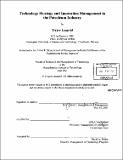Technology strategy and innovation management in the petroleum industry
Author(s)
Laegreid, Trygve, 1959-
DownloadFull printable version (8.705Mb)
Other Contributors
Massachusetts Institute of Technology. Management of Technology Program.
Advisor
Eric A. von Hippel.
Terms of use
Metadata
Show full item recordAbstract
The petroleum industry is a mature commodity business and a high- technology business characterized by a relatively high rate of innovation. Probably the world's largest industry even today, the petroleum industry has an interesting history that has shaped the dynamic energy landscape. The petroleum industry is composed of two groups of companies: the petroleum companies and the oilfield service and sμpply companies. Through mergers and acquisitions BP has grown to the third largest petroleum company and the world's 17th largest company. Statoil is a middle tier petroleum company. Both Statoil and BP are integrated oil companies. This thesis studies the technology strategy and innovation management practices in the two petroleum companies Statoil and BP. A literature review presents the central concepts and models that have been developed in the fields of general strategy, technology strategy and innovation management. The main strategy features are alignment between business, technology and research, underpinned by processes, structures, incentives and culture, and an intelligent user strategy focused on cost reduction. The management of innovation emphasizes cooperation across organizational boundaries, a free and effective market approach to ideas, innovation and technology, and a low appropriability regime for technology. The thesis points to weaknesses and problems related to the present strategy. The present strategy is weak in competitive advantage. The free and effective market that underpins the user strategy is vulnerable. The alignment strategy can lead to strategic and organizational inertia and preclude necessary change. Alignment must be combined with adaptability to be sustainable. The strategy of internationalization through technology leverage requires an ambidextrous organization.
Description
Thesis (S.M.M.O.T.)--Massachusetts Institute of Technology, Sloan School of Management, Management of Technology Program, 2001. "June 2001." Includes bibliographical references (leaves 66-69).
Date issued
2001Department
Management of Technology Program.; Sloan School of ManagementPublisher
Massachusetts Institute of Technology
Keywords
Management of Technology Program.